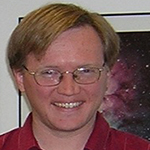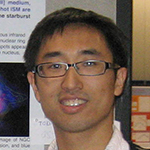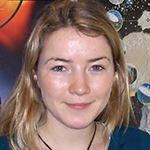CIERA Special Seminars 2011-2012
*Tech = Technological Institute (2145 Sheridan Road)
**Db = Dearborn Observatory (2131 Tech Drive)
| Date/Time | Visitor / Seminar | |
| June 21 11:00 am |
 |
Mark Wardle Magnetically-driven turbulence in protoplanetary discs is thought to mediate accretion onto the central star. Turbulence is suppressed where the ionisation level is too low for the magnetic field to effectively couple to the gas, creating "dead zones" which are a favourable environment for aggregation of solid material and formation of planetesimals. Here I show that the destabilising effect of Hall diffusion in protoplanetary discs may increase or decrease the turbulent column density by an order of magnitude or more, depending on whether the large-scale magnetic field is parallel or antiparallel to the rotation axis, respectively. Previous estimates of the depth and extent of magnetically active layers in protoplanetary discs based on damping by ohmic diffusion are likely to be wildly inaccurate. |
| May 24 4:00 pm |
 |
Jeremy Sepinsky We investigate the exchange of angular momentum between the components of a close white dwarf binary undergoing direct impact accretion. When a quantity of mass is ejected from a white dwarf donor star, conservation of angular momentum necessitates a change in both the orbital and spin angular momentum of the donor star. Similarly, when the mass accretes both the spin and orbital angular momentum of the white dwarf accretor are changed. This exchange of angular momentum is critical in determining the stability of such a mass transfer process. We calculate the instantaneous change in angular momentum during this process and discuss the effect it has on the stability of the system. Finally, we speculate on the surviveability of these systems, which have the potential to merge and create Type Ia Supernovae or remain stable to form AM CVn. |
| May 17 4:00 pm |
 |
Jeff Andrews Although they generally receive less attention, wide binaries composed of two compact objects presumably outnumber their close cousins. Bolstered by our population synthesis results predicting the existence of white dwarf pairs (WDWDs) with up to parsec separations, we search for wide WDWDs using as our candidate primaries the ~12,000 spectroscopically confirmed hydrogen-atmosphere WDs recently identified in the Sloan Digital Sky Survey. Using two techniques to separate random alignments from high-confidence pairs, we find nine new high-probability wide WDWDs and confirm three previously identified candidate WDWDs. This brings the number of known wide WDWDs to 45. Our new pairs are a significant addition to the sample with smaller proper motions (<200 mas/yr) and larger angular separations (>10"). I will conclude with a discussion of how, with spectroscopic follow-up, these pairs might provide constrains on the initial-final mass relation for WDs. |
| April 26 4:00 pm |
 |
Nikta Amiri Intermediate mass stars die extraordinary deaths, ejecting a significant amount of their mass into the interstellar medium, when they make a sudden transition (~1000 years) towards much hotter temperatures (>30,000 K) as compact white dwarfs. Such a heavy mass loss is important in astrophysics as it significantly affects the stellar evolution and influences the chemical composition of the Galaxy. The late stages of the evolution of Asymptotic Giant Branch (AGB) stars and in particular the formation of aspherical PNe is poorly understood. It is not clear why AGB stars exhibit significant asymmetric mass loss at the end of their evolution. The discovery of collimated jets in the stellar environment has opened up a new window to study this fascinating piece of stellar evolution in more detail. Magnetic fields have been proposed as possible agents for forming the striking asymmetries we observe in PNe. Using high resolution radio interferometers, I studied astrophysical masers which occur in the circumstellar envelopes of AGB stars. The results of my work have shown that the circumstellar envelopes of evolved stars show signs of aspherical expansion, traced by maser emission at various distances from the central evolved stars. Furthermore, the observations indicate significant magnetic field strengths, which imply that magnetic fields can have an important role in collimating the jets and shaping the circumstellar environment of dying stars. |
| April 19 4:00 pm |
 |
Tyson Littenberg With LIGO and Virgo completing major upgrades, the first directly detectable gravitational waves are literally on their way to Earth. These signals will land in noisy interferometers and we need robust data analysis procedures to distinguish between astrophysical signals and transient instrument artifacts ("glitches"). Bayesian model selection is well suited to solve this detection problem if the noise were stationary and Gaussian (it isn't). In this talk I will present a new way of modeling the noise in the LIGO/Virgo detectors which accounts for glitches and provides robust Bayesian evidence in realistic simulated data. |
| March 29 4:00 pm |
 |
Casey Lisse We have analyzed Spitzer and NASA/IRTF 2 – 35 μm spectra of the warm, ~350 K circumstellar dust around the nearby MS star η Corvi (F2V, 1.4 ± 0.3 Gyr). The spectra show clear evidence for warm, water- and carbon-rich dust at ~3 AU from the central star, in the system's Terrestrial Habitability Zone. Spectral features due to ultra-primitive cometary material were found, in addition to features due to impact produced silica and high temperature carbonaceous phases. At least 9 x 1018 kg of 0.1 – 100 µm warm dust is present in a collisional equilibrium distribution with dn/da ~ a-3.5, the equivalent of a 130 km radius KBO of 1.0 g/cm3 density and similar to recent estimates of the mass delivered to the Earth at 0.6 – 0.8 Gyr during the Late Heavy Bombardment. We conclude that the parent body was a Kuiper-Belt body or bodies which captured a large amount of early primitive material in the first Myrs of the system's lifetime and preserved it in deep freeze at ~150 AU. At ~1.4 Gyr they were prompted by dynamical stirring of the parent Kuiper Belt into spiraling into the inner system, eventually colliding at 5-10 km/sec with a rocky planetary body of mass ≤ MEarth at ~3 AU, delivering large amounts of water (>0.1% of MEarth's Oceans) and carbon-rich material. The Spitzer spectrum also closely matches spectra reported for the Ureilite meteorites of the Sudan Almahata Sitta fall in 2008, suggesting that one of the Ureilite parent bodies was a KBO. |
| March 26 4:00 pm |
Darek Lis With a 3.5 meter diameter telescope passively cooled to ~ 80 K and a science payload comprising two direct detection cameras/medium resolution imaging spectrometers, PACS and SPIRE, and a very high spectral resolution heterodyne spectrometer, HIFI, Herschel Space Observatory provides extraordinary observational opportunities in the 55 – 672 mic spectral range. The HIFI instrument has opened for the first time the submillimeter band to high-resolution spectroscopic studies. Unbiased spectral line surveys have been carried out in a sample of representative sources, providing a complete molecular inventory of star-forming regions. Molecular lines are important coolants of the dense interstellar medium, and as such regulate its star formation properties. Submillimeter wavelengths furnish access to high-energy rotational transitions, excited in the immediate vicinity of the newly formed stars, thus allowing detailed investigations of the complex, high-temperature chemistry driven by molecules evaporating from grain mantles. Interstellar hydrides, the basic building blocks of astrochemistry, have their fundamental rotational lines in the submillimeter. Velocity-resolved molecular spectra trace the gas kinematics and the line ratios give decisive information about the physical conditions. I will present recent HIFI highlights, from ISM to solar system objects, which demonstrate the outstanding spectroscopic capabilities of HIFI for detecting new interstellar molecules and providing key constraints for astrophysical and astrochemical models. |
|
| March 15 3:30 pm |
 |
Hannah Jang-Condell Type I migration of planets in gas-rich protoplanetary disks is a thorny problem in the side of planet formation theorists. This type of migration comes from tidal interactions between the planet and disk, resulting in angular momentum exchange between the planet and disk, so that the outer disk pushes the planet in and the inner disk pushes the planet out. With typical disk parameters, the torques from the outer disk win and the planet radially drifts inward, on time scales typically shorter than observed disk lifetimes. While this type of migration can readily explain the abundance of Hot Jupiters among known exoplanets, it does not explain why Jupiter still orbits at 5 AU from the sun, nor does it explain how the planets in HR 8799 can get to tens of AU from the central star. In this talk, I will present a new mechanism of halting or even reversing Type I migration, by the opening of a partial gap by the growing planet. Stellar illumination of the gap results in unequal cooling and heating on opposite sides of the gap, creating a local inversion of the radial temperature profile. This change in the radial temperature gradient can change the balance of inward and outward torques on the planet, and thereby reverse the direction of migration. I will also present observational signatures of these gaps in disks. These gaps are currently detectable with existing telescope facilities, and measuring them can put important constraints on the timing and locations of planet formation. |
| Feb 29 4:00 pm |
 |
Craig Heinke The initial growth of supermassive black holes in galaxy cores is not yet understood. Identification of black holes of intermediate mass, larger than those that can be produced from individual stars, is thus of great interest. Several groups have proposed that intermediate-mass black holes (IMBHs) can be formed in the cores of dense stellar clusters. I will survey recent work (including two projects of mine) identifying and studying candidate IMBHs in M15, omega Centauri, M31's globular G1, M82, and ESO 243-49 using X-ray, radio, optical, and infrared telescopes. I conclude that the evidence leans against IMBHs in M15, omega Cen, and G1 (from our recent CXO/VLA campaign), and that there is no evidence that either M82 candidate IMBH is located in a dense cluster. ESO 243-49 HLX-1 is almost certainly a real IMBH, but the optical/UV emission at its location is not coming from a stellar cluster. We have proposed further observations to try to detect or constrain a stellar cluster around it. |
| Feb 9 3:30 pm |
 |
Chris Wegg I will discuss the dynamics of stars and compact objects around closely separated (~1pc) binary supermassive black holes (SMBHs). Binary SMBHs are predicted to be a ubiquitous and inevitable consequence of the merger of galaxies, however there is remarkably little observational evidence for the existence of binaries at this separation at present. I will describe simulations we have performed that show there is an enhanced period (~Myr) of tidal disruptions, during which the tidal disruption rate can be as high as 0.1/yr, four orders of magnitude higher than the canonical rate from isolated SMBHs. We predict therefore that it may be possible to identify binary SMBHs via multiple tidal disruptions from the same galaxy over ~5-10yrs. In addition, I will describe the interesting dynamical processes that stars orbiting the binary SMBHs undergo (apsidal precession, Kozai oscillations, emission of gravitational radiation), and in particular, how the interplay between these can result in the production of extreme mass ratio inspirals (EMRIs) observable by low frequency gravitational wave detectors. |
| Feb 2 3:30 pm |
 |
Ben Lackey University of Wisconsin-Milwaukee Using gravitatinal wave and astrophysical observations to constrain the equation of state of neutron star |
| Jan 26 3:30 pm |
 |
Kristen Menou Comparative planetology now encompasses a large set of extrasolar planets. Recently, direct constraints on the atmospheres of a few exoplanets have become available. I will briefly describe the observational status of this field. I will then report on various efforts to interpret these observations in terms of atmospheric responses to unusual forcing conditions, well beyond the ones found in the Solar System. The future of the field is exciting, with terrestrial planets on the horizon. |
| Jan 27 3:30 pm |
 |
Diana Valencia In the frontier field of exoplanets, super-Earths are the newest class. There is much to be learned about these objects because they do not exist in the solar system. The composition of these planets reflects their initial chemical inventory and early formation processes, such as giant impact collisions and atmospheric evaporation. While inferring the composition of super-Earths and mini-Neptunes is a difficult endeavor given the degenerate character of the problem, it illuminates formation processes in a new parameter space. I will present results on the composition of the transiting low-mass planets and its connection to early formation processes. Interestingly, the subset of super-Earths that are solid (either terrestrial or ocean/icy-like) may have evolved habitable conditions. The thermal evolution of a solid planet is intimately connected to its interior dynamics, which is determined by the behavior of fluid and heat transport under high pressures and temperatures. I will discuss the newest results on the interior dynamics and thermal evolution of rocky super-Earths. This work will help in our search for habitable planets. |
| Jan 18 4:00 pm |
 |
Junfeng Wang It is crucial to improve our understanding of "feedback" in the cosmic evolution and evaluate the impact of starburst and active nuclei driven outflows on galaxy evolution observationally. I will first briefly review recent progress in X-ray imaging of the "mini-starburst"---Galactic massive star forming regions, and then present the latest results from the CHandra survey of Extended Emission-line Regions in nearby Seyfert galaxies (CHEERS, PI: Wang), which offers a unique opportunity to examine feedback in action in much greater detail than at high redshift. In particular, findings in the circum-nuclear regions of two nearby active galaxies, namely the starburst/AGN composite Seyfert NGC 1365 and the archetypal Seyfert 1 NGC 4151 will be discussed in detail. |
| Nov 30 4:00 pm |
 |
Eva Ntormousi We investigate the triggered formation of cold filamentary structure in the ISM with high-resolution numerical simulations of supershell fragmentation and collision. Supershells are commonly observed features in the ISM of the Milky Way and of other galaxies, formed by the combined violent feedback of many young OB stars. These giant bubbles of hot gas are thought to trigger star formation as they sweep up and condense the ambient gas. In our models elongated cold clouds are a natural consequence of the fragmentation and collision of such supershells. We find that in this scenario clouds are created in a variety of physical states, ranging from irregular structures, to clouds in pressure equilibrium with their surroundings to rotating, almost round clumps. Studying metal recycling in this context reveals a very homogeneous metal distribution in the hot superbubbles and practically no metal enrichment of the cold gas. |
| Nov 21 2:00 pm |
 |
Adrienne Cool Hubble Space Telescope and Chandra X-ray Observatory are providing a
veritable gold mine of opportunities to unearth the binary stars that inhabit globular clusters. Binaries play a key role in the complex interplay between stellar and dynamical evolution in clusters. They are also of interest as potential sources of gravitational waves and SN Ia progenitors. I will describe work being done to catch binary stars at multiple stages of their evolution in clusters, from primordial main-sequence binaries to double-degenerate systems. I will discuss results of detailed studies of the nearby high-density cluster NGC 6397, and preliminary results from work on Omega Centauri and NGC 6752. Knowledge of binary populations at multiple stages of evolution can provide valuable tests of increasingly sophisticated numerical simulations of globular clusters. |
| Nov 17 4:00 pm |
 |
Ann-Marie Madigan The Galactic center is home to our nearest massive black hole (MBH). Recent observations of the stars orbiting in its potential have yielded unexpected results. In this talk I will discuss two such puzzles. The first is the presence of a young disk of stars (~ 6 Myr) which contains orbits with both very high and very low eccentricities. The second is a "hole" in the population of late-type stars (> 1 Gyr), in contradiction with the long-standing theoretical prediction of a stellar cusp increasing in density towards an MBH. |
| Nov 14 4:00 pm |
 |
Rich Plotkin Radiative and mechanical outflows from accreting black holes (i.e., winds/jets) interact with their large-scale environments, with important implications for many fields of astrophysics. Nature provides a very diverse set of black holes to study, from stellar mass black holes in binary systems to supermassive black holes driving Active Galactic Nuclei (AGN). In this talk I show how statistical studies comparing black holes across the entire mass scale can afford a more holistic view of black hole accretion. In particular, the fundamental plane of black hole activity -- a relation connecting hard state black holes and their supermassive analogs -- suggests that black holes regulate their output similarly across the entire mass scale, and that accretion physics scales (at least partly) with black hole mass in a predictable way. I will show how the fundamental plane can be exploited as an effective tool to answer the hotly debated question: what is the dominant X-ray emission process in weakly accreting black holes? Along the way I use a well-defined sample of low-luminosity blazars (i.e., BL Lacs) to highlight some important systematic challenges to fitting the fundamental plane. I will also briefly show, from the first statistical study on the mid-infrared properties of hundreds of BL Lacs, that at odds with simple AGN unification, BL Lac dusty tori are intrinsically weak or altogether missing (and not simply diluted by a beamed jet). I will conclude by discussing how this result is expected from black hole mass scaling, and I will also discuss implications on the `nature vs. nurture' debate for radio galaxies and AGN unification in general. |
| Nov 3 4:00 pm |
 |
Manjari Bagchi Dense stellar environments of Galactic globular clusters are known to be effective breeding grounds for binary and millisecond pulsars (MSPs), and there are a number of phenomena hinting a difference between this population from their disk counterpart. We use observed luminosities of the cluster MSPs to investigate this fact. We model the luminosity distribution of MSPs in globular clusters as the brighter, observable part of an intrinsic distribution and use the best-fit models to predict the total number of pulsars in different globular clusters. Although our predictions are not too different from those of other studies using total gamma-ray or radio fluxes form the clusters, we do not find any strong evidence for a correlation between the number of pulsars inferred in globular clusters and globular cluster parameters including metallicity and stellar encounter rate, contradicting previous studies. Moreover, we do not see any clear difference between the luminosity distribution of the cluster pulsars from their disk counterparts. We discuss possible reasons behind this apparent puzzle. |
| Oct 28 2:30 pm |
 |
Phillip Zukin N-body simulations have revealed a wealth of information about dark matter halos, but their results are largely empirical. Using analytic means, we attempt to shed light on simulation results by generalizing the self-similar secondary infall model to include tidal torque. Imposing self-similarity allows us to analytically calculate the structure of the the halo in different radial regimes and numerically compute the profiles of the halo without being limited by resolution effects inherent to N-body codes. I will describe this simplified halo formation model and compare our results to mass and velocity profiles from recent N-body simulations. We find that angular momentum plays an important role in determining the structure of the halo at small radii. |
| Oct 27 4:00 pm |
 |
Snezana Prodan It has been suggested that the 170 day period in the light curve of the low mass X-ray binary 4U 1820-30 arises from the presence of a third body with a large inclination to the binary orbit. We show that this long period motion arises if the system is librating around the stable fixed point in a Kozai resonance. We demonstrate that mass transfer drives the system toward this fixed point, and calculate, both analytically and via numerical integrations, that the period of libration is of order 170 days when the mutual inclination is near the Kozai critical value, which could indicate that the system might had suffered through Kozai migration. The non-zero eccentricity of the binary, combined with tidal dissipation, implies that the rate of change of the binary period would be slower than, or even of opposite sign to, that implied by standard mass transfer models. If the 170 day period results from libration, then, contrary to appearances, the orbital period of the inner binary is increasing with time; in that case, (e/0.009)^2Q/k_2 > 2.5x10^9, where k_2=0.01 is the tidal Love number and e=0.009 is the fiducial eccentricity of the inner binary. It appears unlikely that the observed negative period derivative results from the smaller than expected (but positive) value of period derivative combined with the previously suggested acceleration of the system in the gravitational field of the host globular cluster NGC 6624. |
| Oct 11 4:00 pm |
 |
Mitchell C. Begelman The supermassive black holes that populate galactic nuclei could have grown from an early population of stars, or via the direct collapse of much larger masses of gas. I will discuss recent investigations of the latter possibility, focusing on the physics that may have regulated early black hole formation and growth. Black hole formation by direct collapse implies the existence of hitherto undetected classes of objects; I will outline the prospects for detecting them. |
| Oct 6 4:00 pm |
Susmita Chakravorty Warm absorber (WA) is the ionized gas in the line of sight to the central region of the active galactic nuclei (AGN). The thermal properties and the ionization state of the WA is determined by the atomic interactions between the ionizing continuum and the ions present in the medium whose signatures are found as absorption edges and lines in the soft X-ray spectra at 0.5 - 1.3 keV. We have investigated the influence of the radiation from the accretion disk at 50 eV, the so-called soft excess at 0.5 keV, the 2-10 keV X-ray powerlaw on the nature of the WA. The role of the chemical composition of the absorber has also been studied in details. We find that the systematic study reveals interesting trends in constraining the properties of the ionizing continuum. The chemical composition places tight constraints on the multiphase nature of the gas. |